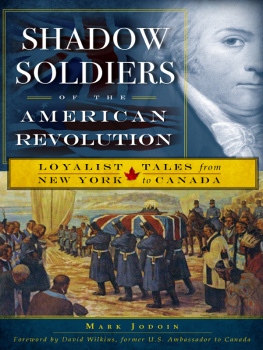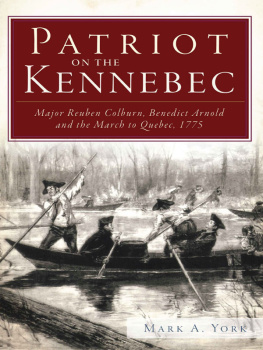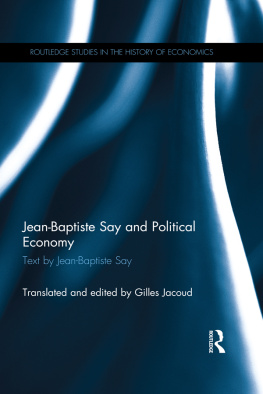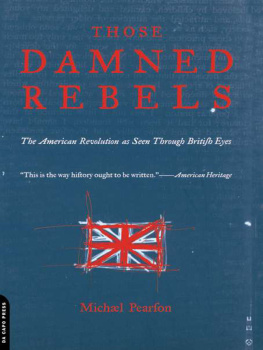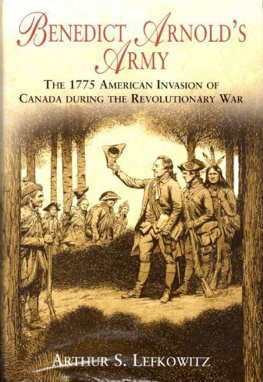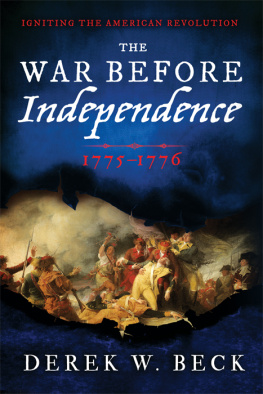THE
INVASION
OF
CANADA
BY THE
AMERICANS
17751776
THE
INVASION
OF
CANADA
BY THE
AMERICANS
17751776
As Told through Jean-Baptiste Badeauxs Three Rivers Journal and New York Captain William Goforths Letters
Edited by
Mark R. Anderson
Translated by
Teresa L. Meadows
Photo credit: Yale University Art Gallery
Published by State University of New York Press, Albany
2016 State University of New York
All rights reserved
Printed in the United States of America
No part of this book may be used or reproduced in any manner whatsoever without written permission. No part of this book may be stored in a retrieval system or transmitted in any form or by any means including electronic, electrostatic, magnetic tape, mechanical, photocopying, recording, or otherwise without the prior permission in writing of the publisher.
For information, contact State University of New York Press, Albany, NY
www.sunypress.edu
Production, Jenn Bennett
Marketing, Fran Keneston
Library of Congress Cataloging-in-Publication Data
The invasion of Canada by the Americans, 17751776 : as told through Jean-Baptiste Badeaux's Three Rivers journal and New York Captain William Goforth's letters / edited by Mark R. Anderson; translated by Teresa L. Meadows.
pages cm
Includes bibliographical references and index.
ISBN 978-1-4384-6003-1 (hardcover : alk. paper)
ISBN 978-1-4384-6005-5 (e-book)
1. Canadian Invasion, 17751776. 2. Badeaux, J. B. (Jean Baptiste), 17411796Diaries. 3. Goforth, William, 17311807Correspondence. 4. Canadian Invasion, 17751776Sources. I. Anderson, Mark R., 1966 editor. II. Meadows, Teresa L., 1955 translator. III. Title: Jean-Baptiste Badeaux's Three Rivers journal. IV. Title: New York Captain William Goforth's letters. V. Title: Jean-Baptiste Badeaux's Three Rivers journal and New York Captain William Goforth's letters. VI. Title: Invasion du Canada par les amricains en 1775.
| E231.I63 2016 |
| 971.02'4dc23 | 2015015564 |
10 9 8 7 6 5 4 3 2 1
Contents
Illustrations and Maps
| . |
| . |
| . |
| . |
| . |
| . |
| . |
| . |
| . |
| . |
| . |
| . |
| . |
| . |
| . |
| . |
| . |
| . |
| . |
| . |
| . |
| . |
| . |
| . |
| . |
| . |
Acknowledgments
This work was made possible only by the help of many associates and institutions. The kind staffs at the Library and Archives Canada, the New-York Historical Society, and Bibliothque et Archives Nationales de Qubec offered tremendous access to their wonderful collections. Those institutions, as well as Columbia University in the City of New York, the American Philosophical Society, and the Public Library of Cincinnati and Hamilton County have also given invaluable assistance in accessing treasured materials from more than a thousand miles away, as we work from our homes in Colorado. The interlibrary loan staff at Pikes Peak Library District provided vital support in obtaining the full range of books and articles necessary to complete this project.
It is a fantastic time to do historical research, as virtual access to primary and secondary sources grows by leaps and bounds each year. We commend the Bibliothque et Archives Nationales de Qubec for their expansive digitization of manuscript collections, providing researchers the ability to remotely view documents deep in some of the most obscure portions of their holdings. The Universit de Montral Research Program in Historical Demography parish records database was another critical toola means to readily access vital details of most of the Canadian historical characters lives and families.
We also must thank our family, friends, and fellow professionals for their contributions: Transcription assistant Kira Anderson, who helped decipher William Goforths messy and nearly illegible letters; Pam Anderson and Dave Eblen, who willingly proofread drafts at every stage; Professor Michael Gabriel, who has generously continued to encourage and guide this editor/author through the world of academic history and publishing; Associate Professor Fabienne Moore who kindly lent her expertise in eighteenth-century French language and culture to both appropriate translation and reading of difficult script; and colleagues at the University of Colorado Colorado Springs, the University of Oregon, and the University of Rochester who were interested enough to spend time simply discussing the period, the text, and the translation.
Abbreviations Used in Footnotes
AA4 = Force, Peter, ed., American Archives: Fourth Series
AA5 = Force, Peter, ed., American Archives: Fifth Series
AMP = Alexander McDougall Papers, 17591795, NYHS
BAnQ = Bibliothque et Archives nationales Qubec
DCB = Dictionary of Canadian Biography Online/Dictionnaire biographique du Canada en ligne
JCC = Ford, Worthington, Journals of the Continental Congress, 17741789.
LAC = Library and Archives Canada
LoD = Smith, Paul H., ed., Letters of Delegates to Congress, 17741789
NARA = United States National Archives and Records Administration
NYHS = New-York Historical Society
NYPL = New York Public Library
PGWRWS = Chase, Philander, ed., The Papers of George Washington: Revolutionary War Series
PSP = Philip Schuyler Papers, NYPL
SoFR = State of the Four Regiments, 4 August 1775, NARA, M853, rg93, v5, r15, p152
UMPRDH = Universit de Montral, Programme de recherche en dmographique historique
Footnotes that begin with (date) are cross-referenced.
Introduction
On its own merits, Canadian notary Jean-Baptiste Badeauxs record, commonly known as the Journal of the Operations of the American Army during the Invasion of Canada in 177576, authors remarkable writing skillsthe notarial skills they required for documenting local civil and judicial activities were easily transferred to journal keeping during such momentous times. Badeauxs account, however, stands out from the others.
Most importantly, Jean-Baptiste Badeaux provides a uniquely objective view of the invasion. While he repeatedly and explicitly clarified his staunch loyalist stance in his journal, Badeaux, unlike his vehemently partisan counterparts Sanguinet or Berthelot, made a remarkable effort to simply state the facts surrounding events. He avoided the temptation to put all of the invading Continentals actions in the worst light, and he deliberately weighed the veracity and bias of secondhand reports received from outside his home district. Additionally, Badeaux offers the reader occasional glimpses of his sly wit, and a sprinkling of self-deprecation, giving his journal a warmer, more intimate feel.


